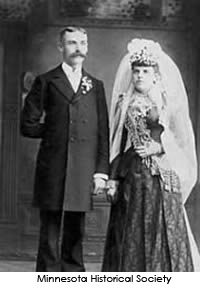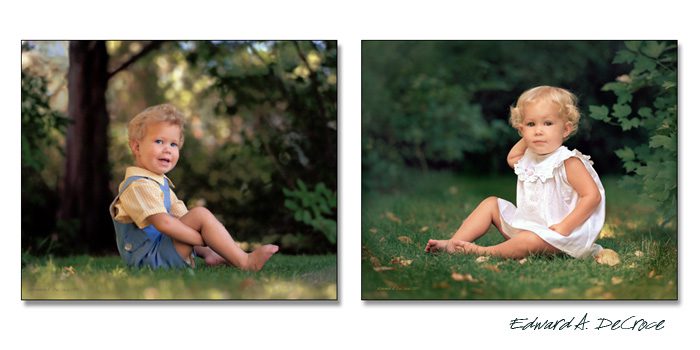by Edward C. deCroce
.
.
This synopsis is not meant to be an all-inclusive history of wedding and event photography. More than anything, these are my impressions of the craft gleaned from hanging around it for 50 years. It’s written to remind us that with each new advancement in photography comes a new style.
.
.
While teaching workshops to photographers, it dawned on me that many of them had no recollection of film. Their experience in photography had no connection to chemistry at all. And when I mentioned starting as a young boy carrying 4×5 film holders, I could see by their vacant expressions, that they had never held a view camera. So with each new seminar, I now bring along some of the old cameras with which I’ve worked – the Speed Graphic, the Rolleiflex, the Hasselblad. The point? Within each stage of photography development there is a particular style of picture that was born from that era. We are often unaware of the connection. Take for example the first paragraph below. The slow shutter speed lead to very stoic still picture right?. Yet even today we find ourselves stopping and posing for the camera. As you read this brief history, try to think of the style of picture associated with each technical breakthrough. Then think of how we still unwittingly use those styles in the photographs we make today.
Wedding photographs were originally shot in a controlled studio environment. At the dawn of photography in the mid 1800s, pioneer photographers began depicting the world around them. Wedding couples were eager to have their likenesses scribed in light onto the original tin daguerreotypes. Dressed in their best attire, the bride and groom posed while the photographer ignited a plate of magnesium powder and opened his lens with a Packard shutter. The duration of the exposure was determined by the amount of air passing through a rubber hose from a rubber ball squeezed by the photographer. Since exposure lengths ranged from several seconds to several minutes, early photography subjects had to remain as still as possible.  Photographers even invented body braces to help keep their subjects from moving too much. The result was an expressionless and motionless portrait.
Photographers even invented body braces to help keep their subjects from moving too much. The result was an expressionless and motionless portrait.
.
.
Photography evolved with the times and photojournalism was soon born. Images depicted the action from battle fields. Shutters quick enough to stop the action of a galloping horse were invented. But for the most part, wedding photography remained as stoic still poses. Even today, it’s not uncommon for people to stop in procession to pose when they notice a camera pointed their direction. The subconscious notion that a portrait must be serious and motionless is certainly tied to the Packard shutter and long exposures.
Studio photographers continued to work under the dark cloth during the early 20th century. Their camera choice was usually an 8×10 or 5×7 format. Film holders made of wood and metal could hold up to two sheets of film. Meanwhile, amateur cameras like the Brownie enabled the average user to capture home life and travel images that could tell a story. Rather than exposing a single plate of film, rolls of film were able to record up to twelve images. Professionals, however, were not so quick to jump to roll film. Throughout the mid 20th century, press, military, and event photographers used a 4×5 view camera. Equipped with a rangefinder for quicker composing, the 4×5 was relatively light weight.
In the 1950s, roll-film cameras became more popular with professionals. Hollywood movies were recorded on 35mm. And the 35mm camera was created as a means to utilize leftover short film strips. Mirroring the smallish 35mm format was what was dubbed the medium format. With a 6 centimeter width, it could almost compete with the quality of 4×5. Medium format and 35mm cameras soon offered even more versatility with interchangeable lenses.
Equipment advancements in the last quarter of the 20th century allowed professional photographers the tools to capture events in a more documentary style. Influenced by newspapers and magazines like Life and Look, event photographers were now offering “candids” along with the posed. Beginning in the 1950s color film transformed the photography world and offered yet another level of realism.
The word photography comes to us from Greek. Its literal translation is something like “painting with light.” And as cameras advanced, so did the methods to create the light necessary to expose the film. By the 1970s, electronic flashes replaced one shot flash bulbs allowing picture takers increased freedom to stay in the moment. With roll film and continuous flash, photographers could record entire scenes without pause. Flashes became bigger and better as their recycle times decreased.
By the 1980s, the f-8 school of event photography was in vogue. The basic premise was to simply overpower whatever ambient light existed. Shooting at f-8 gives a greater depth of field and provides an almost studio-like level of crispness and sharpness to the images. One obvious problem of this style is the lack of three dimensional space. Outdoor images appeared less realistic, as if the subject were against a painted backdrop while Indoor pictures often looked like they were shot in a tunnel. And dark haired people would blend into the background without separation. To alleviate the effect, photographers used additional portable lights either on stands or held by assistants aimed from the side or behind the subject. With additional lights, photographers could attempt to recreate existing or ambient condition.
Shortly thereafter, and paralleling the f-8 school, some professional photographers also began to offer their clients photojournalism. Lens improvements allowed pictures to be captured at f-2.8. And the notion of employing an unobtrusive reportage photographer at an event appealed to sophisticated clientele.
The revolution of digital photography is unmistakably the biggest advancement in the history of photography since the daguerreotype. Digital photography opened the doors to millions of people suffering from nyctophobia (fear of darkness) or more precisely, fear of the darkroom.
,
,
,
Digital Wedding Photography
At the turn of the century, few photographers could have envisioned the rapidity with which the digital world would transform the way professionals work. While this is a subject for an entire week long seminar, these are a few noticeable differences.
.
Multiple image capture. Fifty years ago, 4×5 sheets were exposed one at a time. There were two sheets of film on a 4×5 holder. In the last quarter of the twentieth century, photographers shot 12 or 24 frames on rolls of film on 6c x 6c (2 1/4” x 2 1/4”). The in- vogue camera was the Swedish Hasselblad, although many photographers worked with the 6×7 Mamiya. 35mm cameras could record 4 frames per second and sports photographers could shoot 100 feet of film. Today’s cameras capture 8 or more frames per second on tiny memory cards capable of holding thousands of raw images.
.
Weight. Although photographers are constantly adding more gizmos and gadgets, professional digital cameras are decidedly less cumbersome and lighter than their predecessors.
.
Processing. Most photographers sent all their color film to the lab and sweated for a week to see the results. In 2011, photographers often download all their images as soon as a shoot is finished. Some even show results from the ceremony during the reception. And a few even boast that the couple’s album will be designed before they depart for their honeymoon. The result has been an expectation that fine photography can be captured, and edited instantaneously.
.
Post processing. In the old film days, each print was corrected or enhanced individually. For major problems, negatives could be retouched or prints could be airbrushed. On the computer, a file can be manipulated through Photoshop, Lightroom, or another application, and an entire batch of similar images can be adjusted. Post processing is still time consuming. There is no quick fix button to transform a mediocre picture into a work of art. But computer applications have allowed novice shutterbugs to vastly improve an average snapshot. And phone cameras have given easy access to budding shutterbugs.
.
.
How I work.
.
.

My style is primarily photojournalistic. I try to make posed picture taking fun and spontaneous. Most important, when the day is done, I want my client to possess archival beauty that lasts. I believe in blending in rather than controlling the event. Too much direction can spoil spontaneity. So the type of client I’m looking for and who is attracted to me, is a bit more established. They already have a pretty clear idea of what they want or don’t want at their wedding. I’m based in Colorado and although I often call my self a Denver photographer, I also travel frequently for wedding photography and for corporate and commercial photography assignments.
When it comes to wedding photography, I believe complete wedding photography is also a blend of four kinds of photography:
1) Photojournalism – more than a series of random snapshots. Finding the picture that tells the story comes from anticipation, patience, and perseverance. 2) Fine art photography – work that provokes an aesthetic emotion. 3) Fashion photography – stretches our imagination to seek the unusual in body and apparel. 4) Classical portraiture – the kind of image that will be passed down through the generations, is at the core of photographic history.
And for a photographer in Denver or anywhere, to truly make their mark , they must become a a master at all four of these.
‘
‘
‘
My mentor was my father Edward A. DeCroce. Originally trained as an aerial photographer at Lowry Air Force base in Denver, he founded DeCroce Studio in 1960. His worldwide acclaim came as a result of portraits that told a story. He was a great speaker and teacher who traveled the world giving lectures, seminars, and workshops. Never a technical wizard, he pushed his profession out of the studio and pioneered the outdoor environmental portrait. His secret formula was to find the light rather than create it. He always shot at f-4 @ 1/15 to 1/60 sec. And he believed in using only the tools and lights that were necessary to do the job.

These child portraits from the early 1970's were created by Edward A. DeCroce. His style was to find the light rather than to create it.
